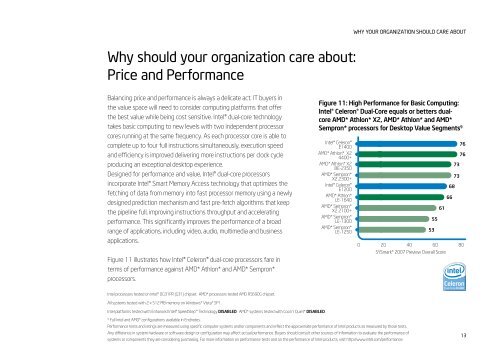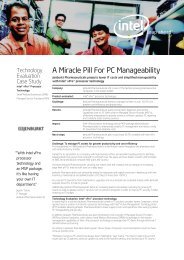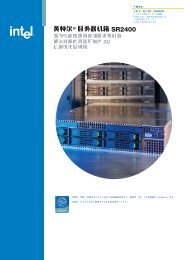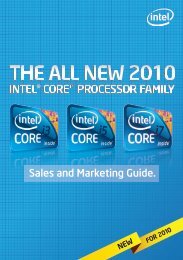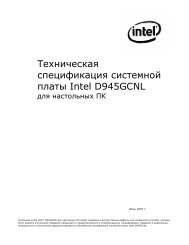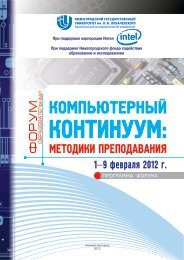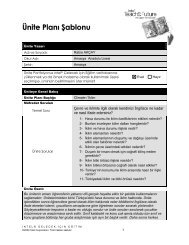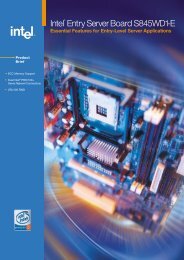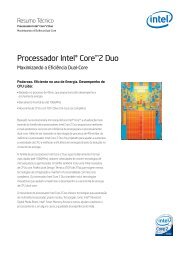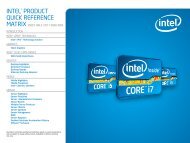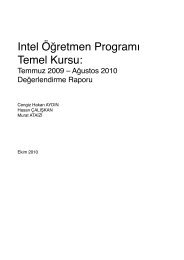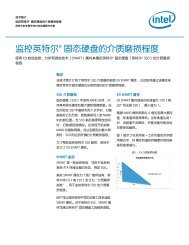Choosing the Right Client Computing Platform For Public Sector - Intel
Choosing the Right Client Computing Platform For Public Sector - Intel
Choosing the Right Client Computing Platform For Public Sector - Intel
You also want an ePaper? Increase the reach of your titles
YUMPU automatically turns print PDFs into web optimized ePapers that Google loves.
Why should your organization care about:<br />
Price and Performance<br />
Balancing price and performance is always a delicate act. IT buyers in<br />
<strong>the</strong> value space will need to consider computing platforms that offer<br />
<strong>the</strong> best value while being cost sensitive. <strong>Intel</strong>® dual-core technology<br />
takes basic computing to new levels with two independent processor<br />
cores running at <strong>the</strong> same frequency. As each processor core is able to<br />
complete up to four full instructions simultaneously, execution speed<br />
and efficiency is improved delivering more instructions per clock cycle<br />
producing an exceptional desktop experience.<br />
Designed for performance and value, <strong>Intel</strong>® dual-core processors<br />
incorporate <strong>Intel</strong>® Smart Memory Access technology that optimizes <strong>the</strong><br />
fetching of data from memory into fast processor memory using a newly<br />
designed prediction mechanism and fast pre-fetch algorithms that keep<br />
<strong>the</strong> pipeline full, improving instructions throughput and accelerating<br />
performance. This significantly improves <strong>the</strong> performance of a broad<br />
range of applications, including video, audio, multimedia and business<br />
applications.<br />
Figure 11 illustrates how <strong>Intel</strong>® Celeron® dual-core processors fare in<br />
terms of performance against AMD* Athlon* and AMD* Sempron*<br />
processors.<br />
<strong>Intel</strong> processors tested on <strong>Intel</strong>® DG31PR (G31) chipset. AMD* processors tested AMD RS690G chipset.<br />
All systems tested with 2 x 512 MB memory on Windows* Vista* SP1.<br />
<strong>Intel</strong> platforms tested with Enhanced <strong>Intel</strong>® SpeedStep Technology DISABLED. AMD* systems tested with Cool n’ Quiet* DISABLED.<br />
9 Full <strong>Intel</strong> and AMD* configurations available in Endnotes.<br />
Figure 11: High Performance for Basic <strong>Computing</strong>:<br />
<strong>Intel</strong>® Celeron® Dual-Core equals or betters dualcore<br />
AMD* Athlon* X2, AMD* Athlon* and AMD*<br />
Sempron* processors for Desktop Value Segments 9<br />
<strong>Intel</strong>® Celeron®<br />
E1400<br />
AMD* Athlon* X2<br />
4400+<br />
AMD* Athlon* X2<br />
BE-2350<br />
AMD* Sempron*<br />
X2 2300+<br />
<strong>Intel</strong>® Celeron®<br />
E1200<br />
AMD* Athlon*<br />
LE-1640<br />
AMD* Sempron*<br />
X2 2100+<br />
AMD* Sempron*<br />
LE-1300<br />
AMD* Sempron*<br />
LE-1250<br />
Performance tests and ratings are measured using specific computer systems and/or components and reflect <strong>the</strong> approximate performance of <strong>Intel</strong> products as measured by those tests.<br />
Any difference in system hardware or software design or configuration may affect actual performance. Buyers should consult o<strong>the</strong>r sources of information to evaluate <strong>the</strong> performance of<br />
systems or components <strong>the</strong>y are considering purchasing. <strong>For</strong> more information on performance tests and on <strong>the</strong> performance of <strong>Intel</strong> products, visit http://www.intel.com/performance.<br />
WHy yOuR ORganizatiOn SHOuld CaRE aBOut<br />
53<br />
55<br />
61<br />
0 20 40 60<br />
80<br />
SYSmark* 2007 Preview Overall Score<br />
68<br />
66<br />
73<br />
73<br />
76<br />
76<br />
13


